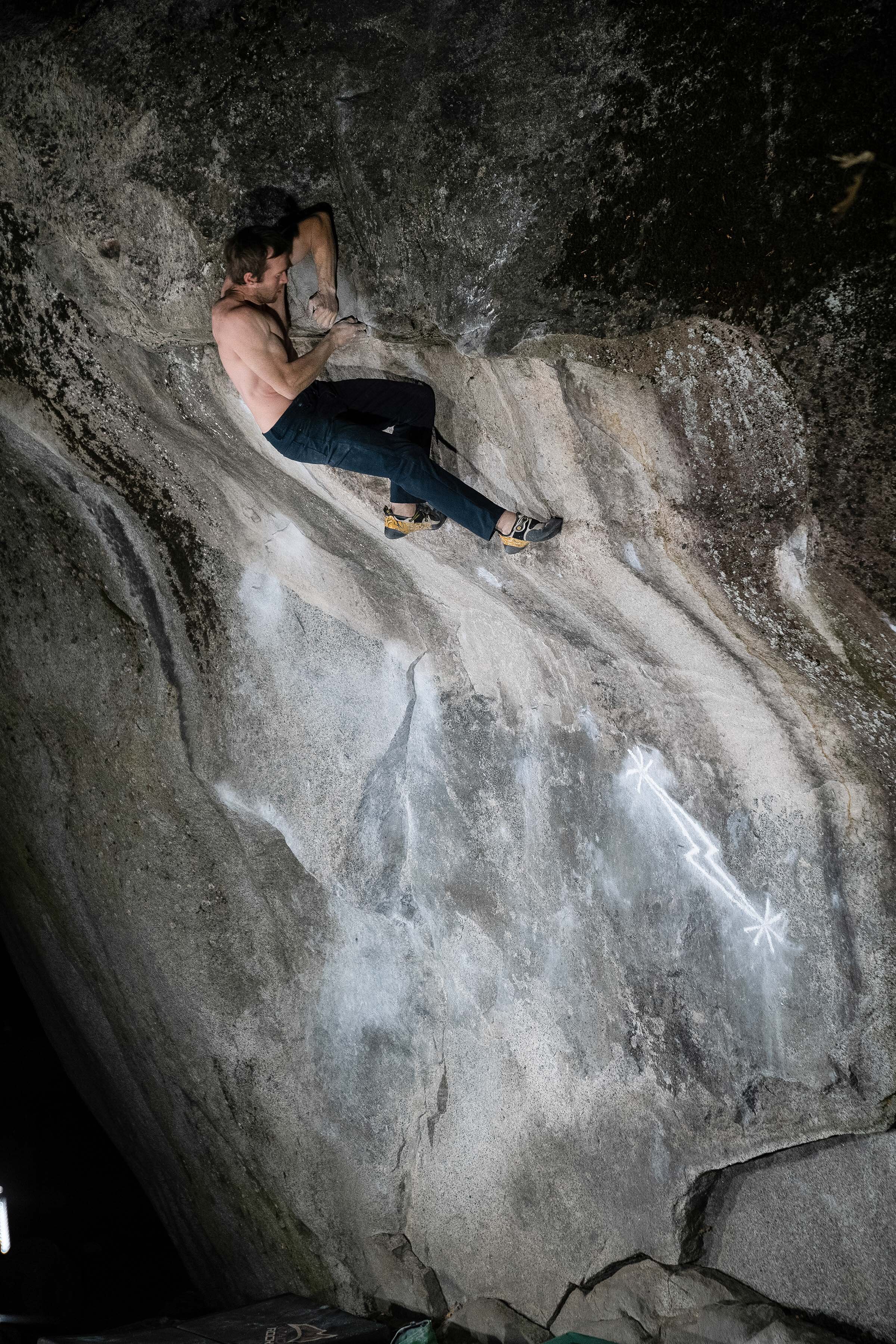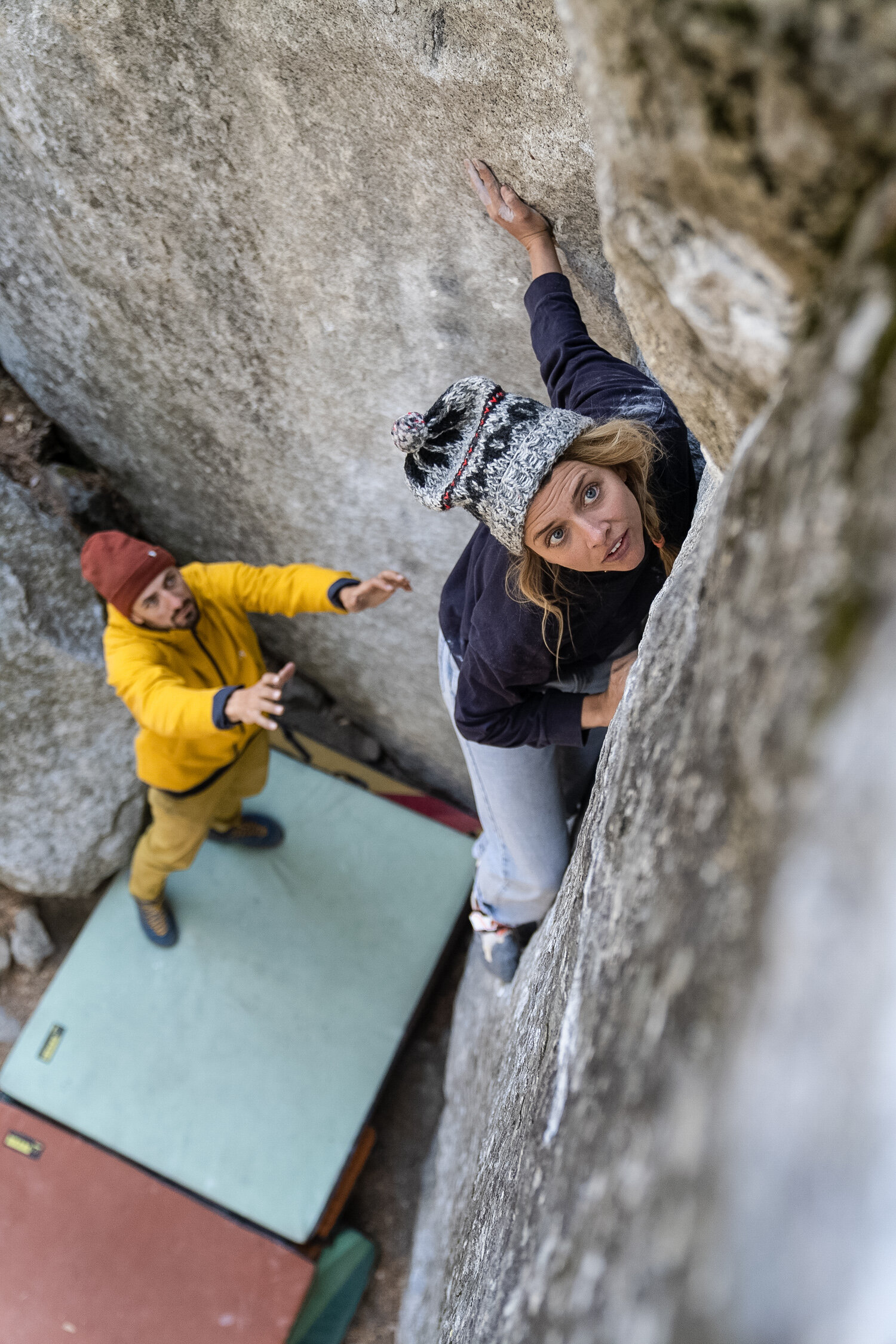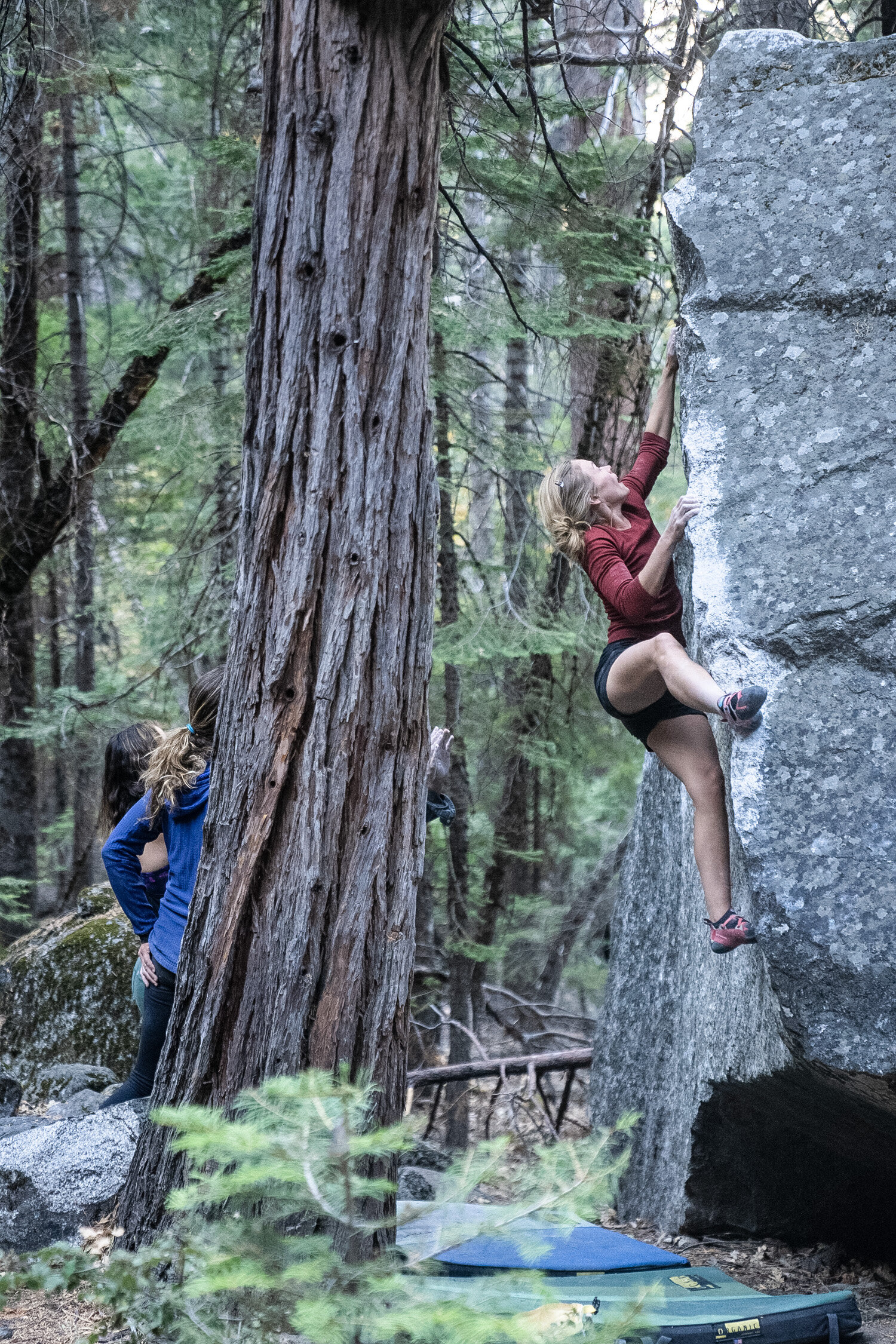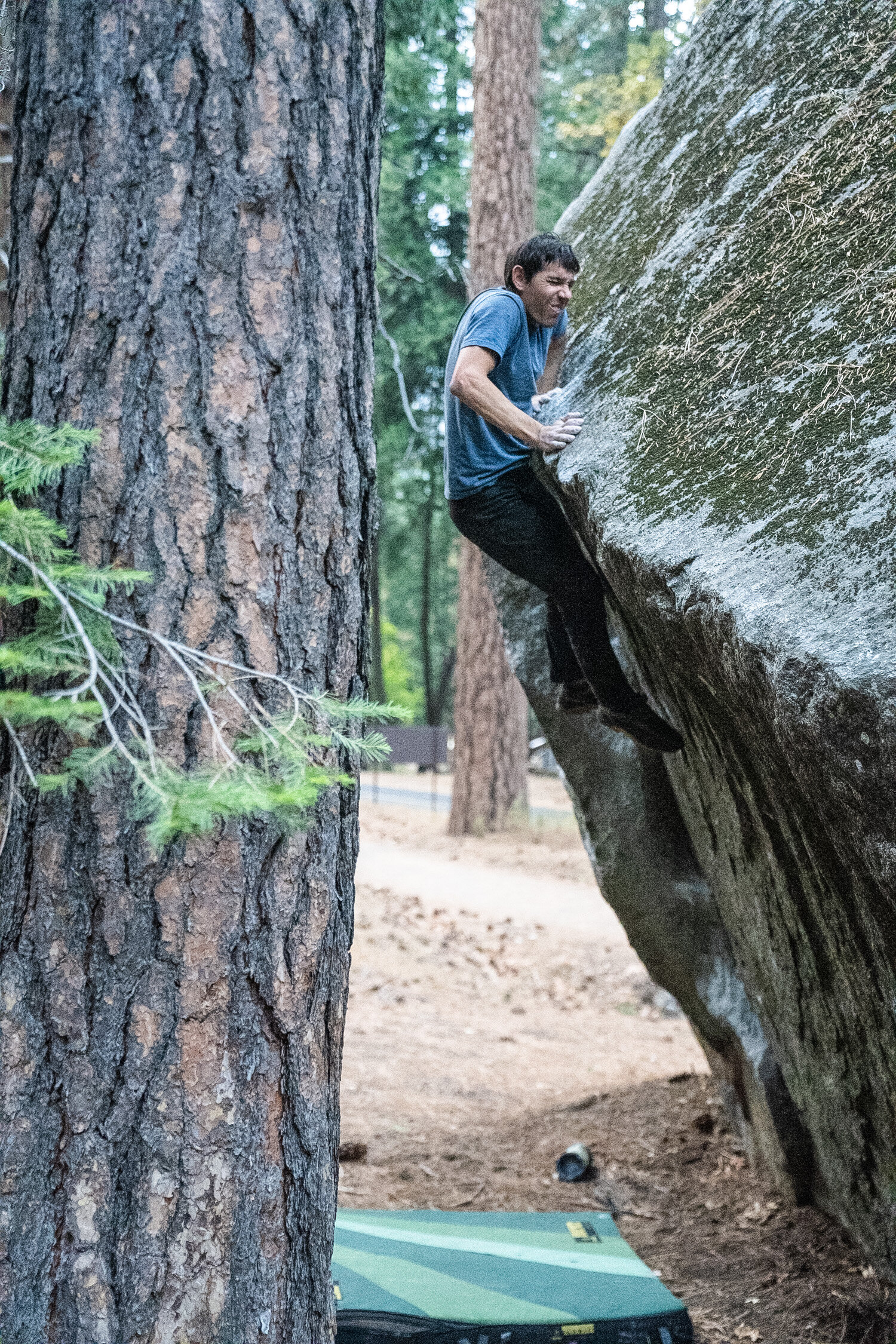Beyond the Bolt
“I drew the original bolt on Midnight Lightning,” wrote John Bachar in a June 2007 SuperTopo forum post. “It was Yabo [John Yablonski] who actually ‘found’ Midnight Lightning. He was sitting in front of it one day and came over to me and Ron Kauk and said he found a new boulder problem. He said it would go. We laughed and said it was impossible. We thought there was about as much chance of doing it as there was the chance that a lightning bolt could strike at midnight (like in the Hendrix song ‘Midnight Lightning’)—so I drew a bolt on it in chalk. That’s it—pretty stupid, huh?”
Dean Fidelman shot of me on Midnight Lightning (V8)
In 1978, Ron Kauk jumped to a jagged edge— the “lightning bolt hold”—on the Columbia Boulder, a giant block dead center in Camp 4. He matched, swung his feet across the wall, and threw his body into a committing mantel. Kauk pressed out the smooth granite and completed the first ascent of Midnight Lightning. Bachar soon followed suit. When a hold broke, Bachar repeated the problem. Sometime later, Kauk reinforced the lightning bolt hold. In 1986, Yabo made the tenth ascent. In 1988, Lynn Hill completed the first female ascent. Climbers have lapped the problem over a dozen times in one session, and a few have climbed it barefoot. After completing the problem, Bachar drew the bolt, cementing its iconic status. In the ensuing decades, Midnight Lightning became Yosemite’s “only” boulder problem—it eclipsed all others. And then for a week and a half in April of 2013, the lightning bolt disappeared.
Below three-thousand-foot cliffs and massive waterfalls, amidst ponderosa pines and sequoias, amongst talus fields and forests, and covered in pine needles and moss carpets sit the quiet boulders of Yosemite. Five years ago, I started writing a new bouldering guidebook to the Valley, documenting its signature problems up smooth slabs, sharp cracks, rounded arêtes, and slick faces dotted with tiny crimps. As my friend Shannon Joslin, a boulderer from Folsom, California, and I tried to document both the history and the current development, however, new problems kept cropping up. All told, when our book comes out in early 2018, it will feature more than 1,200 problems—hundreds more than the singular Midnight Lightning that’s become synonymous with Yosemite bouldering.
Yosemite’s bouldering history dates back at least to the late 1940s/early 1950s. Back then, Allen Steck, Royal Robbins, Yvon Chouinard, Jeff Foote, and Chuck Pratt established problems in Camp 4. They focused primarily on mantels and slabs around the Columbia Boulder and the Wine Boulder, a similarly sized boulder a thousand feet north. Like the Bleausards who used the boulders of Fontainebleau to train for Les Alpes, the Valley crew used the boulders around Camp 4 to train for the Sentinel, Half Dome, and El Capitan. The boulders became the laboratory for pin and head placements in the back of Camp 4, for overhanging bolt ladders on the LeConte Boulder, for chiseling footholds that grant access to the west side of Columbia Boulder, and later for reinforcing holds with glue in the ethical DMZ that was the 1980/1990s.
Shawn Rabatou climbs high on King Air (V10)
In autumn 1963, Colorado climber Layton Kor snagged one of the Camp 4 plums when he climbed a smooth wall of green streaks northwest of the parking lot. The Kor Problem, today given V3, became a test for big-wall climbers to see if they were ready for the larger routes. Five years later, Pat Ament and Dick Dickworth walked from Camp 4 to an arête—what would become the Ament Arête (V4)—next to the Yosemite Falls Trail. Ament greatly influenced Yosemite rock climbing. With a history in gymnastics, he brought chalk to the Valley, an idea that helped revolutionize the climbing game. The men climbed in Spiders and Kronhoeffers, far cries from modern sticky-rubber shoes. Nonetheless, in 1968, Ament climbed a smooth face right of Ament Arête. It was repeated a few years later by Ron Kauk, named the Kauk Slab, and later graded V8.
In the 1970s, Dale Bard, John Long, Mike Graham, John Bachar, and Ron Kauk pushed the difficulty further. Classics around Camp 4 like the slab eliminate Blue Suede Shoes (V5), Battle of the Bulge (V6), and the highball Shiver Me Timbers (V5) were all established. The boulderers began a slow progression beyond Camp 4. Bard walked to the south side of the Valley below the Sentinel where he developed the B1 Boulder, a house-sized chunk of granite. Sans pad, Bard put up No Holds Bard (V7), an eighteen-foot line of crimps over a wooded landing. Bachar walked over to the east side of the Valley to Housekeeping Camp and established Purple Barrel (V7), and later Crossroads Moe (V6) near Bridalveil Falls. These men, part of a core crew of Southern California climbers later dubbed the Stonemasters, pioneered free climbing in the United States in the 1970s and the 1980s, making the first free ascent of Astroman (5.11c), climbing the Nose in a day for the first time, and establishing dozens of new routes on El Capitan.
Most of their bouldering revolved around getting fit for the longer climbs. On the underbelly of a pit-like boulder in Camp 4, Bachar climbed the roof crack Bachar Cracker (V4), and a mattress hid below the problem to safeguard the landing. “We did it for training. There was no gym,” Bard said of doing hand traverses near Swan Slab, a few minutes from Camp 4.
Standards were slowly pushed. In 1984, Kauk added Thriller (V10), a highball line of crimps up a looming face in Camp 4. In 1991, Moffatt added The Force (V11), a few feet left of Thriller. However, a hold was reinforced on the problem. “There was so much glue you weren't even grabbing the hold—just glue,” Bachar wrote in a 2009 SuperTopo post. Bachar, ever the purist, then “used my nail clipper file thing to pry the hold off.” In 1993, Jerry Moffatt skipped on climbing the Nose with Kurt Albert and instead linked together a series of natural flat edges on the back of the Wine Boulder, establishing Dominator as the benchmark V12. Tellingly, in terms of how compressed/sandbagged bouldering grades are in Yosemite, only a few problems harder than “V12” have been established since.
Nik Berry stems up King Cobra (V8)
“If I cleaned it, I wanted to do it first,” Yosemite bouldering pioneer Rick Cashner said. In the 1990s, Cashner was turned on to a treasure trove of bouldering below the Cathedral Spires by El Portal resident Ken Yager and San Diego–based Stonemaster Kevin Worrall. The thing was, he wasn’t quite ready to share it until he’d picked the plum lines up this cluster of a dozen boulders in the shade of the Valley’s south side. So Cashner parked away from the standard trailhead, making a longer walk so climbers wouldn’t know where he was climbing. “It was my secret,” Cashner said. Yager returned to the boulders with Dean Potter and the pair saw Cashner’s chalk all over the rocks. The secret was out. Potter began climbing there with Cashner, and together the pair developed most of the problems—ever in stealth mode. As they walked to the trailhead, the men would cover their faces with one hand so as not to be recognized by other climbers driving by. Occasionally, however, other climbers would swoop in to bag a first ascent. Keeping any climbing area secret, especially in a geographically and socially small climbing community like the Valley’s, can be difficult if not impossible.
One day in late 1996/early ‘97, Cashner and Potter saw a couple of unknown cars at the Cathedral trailhead. At the King Boulder, the centerpiece, house-sized boulder at the Cathedral Boulders, they saw Kauk, video camera in hand, taping Moffat on the center line, one of Potter’s projects. “He was kind of burning us off,” Cashner said of his friend Moffatt “stealing the ascent.” After the incident, they named the problem Behave (V8).
A lot of these new finds were established pre-pad era, like So Good (V5) at Cathedral, the Generation Boulder on the west end of the Valley, and the Woodyard Arete (V6). First ascentionists developed the problems on toprope and then later “free soloed” them. They used this headpoint style to avoid breaking their ankles on the flat or rocky landings. In some cases, a little landscaping went on, including the buried pallet below the base of the Thriller Boulder in Camp 4. As pads came into the Valley, Cashner and Potter began using them. “We used to boulder, and it felt like cheating when we had a towel to wipe our feet off,” Cashner says. “Now I go there and feel naked without all my crashpads.”
Jesse Talley on Once Upon A Time (V3) at Candyland
In the past decade, pads have allowed climbers to push the heights, if not difficulty. In 2009, Randy Puro dropped six pads below Ron Kauk’s 30-foot two-bolt 5.13c, Two Bolts or Not to Be, and bouldered it out. Puro also bouldered out Ben Moon’s Horse Trail problem Egyptian (V10), which had been an obscure toprope for decades. In 2010, Dean Potter dropped a nest of pads below an undone monster line on the LeConte Boulder, climbing the 40-foot King Air (V10), a jump to an arête followed by a hard move off a heel hook sandwiched between two practice aid climbs. In 2015, National Park Service employee Keenan Takashi sent the 30-foot Zephyr (V12) at the Crumbs, located below the Cookie Cliff. While the crux comes low, a slopey V7 arête with your heels 25 feet above the landing guards the summit. “I did Evilution the month before, and Zephyr was way, way, WAY scarier,” says Takashi. “To this day, it's probably the most scared I've been bouldering.” As Bay Area boulderer and Yosemite climber of 20 years Paul Barraza says, “Bouldering didn’t really get that much safer with pads; people just went higher up. It’s an arms-race kind of thing.” Highballing in Yosemite has become so extreme that, in 2017, Alex Honnold, who completed the first ascent of Kaboom (V8) at the Sentinel Boulders, even bouldered out the Freerider, a 3,000-foot V7 on the south face of El Capitan.
Sanni Honnold climbs an unnamed arete at the Cathedral Boulders (V2)
“It’s my turn,” Lucho Rivera said, grabbing the holds on a 15-foot moderate arête. It was 2005, and we’d heard about a collection of new boulders at the Yosemite Lodge Cafeteria. We hustled to the area, in the dense woods below the Lost Brother. Here, in 1998, Marcos Nunez had climbed Don’t Believe the Hype, an immaculate 5.11 corner. Matt Wilder, who was updating the old Don Reid bouldering guidebook, and others were brushing off new problems and calling the area Candyland. In the end, it would yield 50 new problems. After seeing the striking arête, my friends and I all started grabbing the holds, climbing on top of each other to be the first. Lucho sorted the opening moves. Walt Dickinson found a crimp back to the left. Zach Romero brushed holds. Lichen sprinkled on my head as they scrubbed while I climbed. I grabbed the crimp and made a big move to a jug on the arête. I stuck it. My feet pedaled on the dirty granite as I continued to the top, ecstatic.
“Let’s call it the James Lucas Memorial Arête Problem,” I said that night as we hung out in the boulders above Camp 4. Lucho thought the name sounded dumb. Walt wanted to name it It’s Not Your Turn. In Joshua Tree, there’s a John Bachar Memorial Face Problem and a Lynn Hill Memorial Face Problem. When these Stonemasters were climbing in Joshua Tree, they were just a bunch of kids, kind of like we were. The Stonemasters named problems after themselves. Plus, after I’d fallen a hundred feet free soloing in Joshua Tree in 2004 and survived, the arête marked my return to climbing.
“Sure,” Zach said. “Let’s call it the JLMAP.”
I had started bouldering in Yosemite in 2001 as an employee at the Yosemite Lodge. I’d make beds and then like many Concession employees would climb on the moderate problems of Curry and Housekeeping, just a 10- and 20-minute walk from my tent-cabin door respectively. I had a copy of Don Reid’s second edition guide to the boulders, which had grown to 68 pages and included over 500 boulder problems since the smaller, 1992 first edition. My perception, much like that of the early Yosemite climbers, was that the bouldering was secondary to the routes. I’d climb on the finger and hand cracks that split the 10- to 15-foot boulders below Staircase Falls, on the Horse Trail, and along the road near the chapel. I dreamed of completing the harder crack circuit, of climbing Jason Campbell’s tight-hands Lost Brother testpiece Deliverance (V8), Dean Potter’s heinously pin-scarred Sasquatch (V11) on the Leconte Boulder, or even thrashing through Cedar Wright’s riverside 30-foot offwidth roof crack Cedar Eater (V5). Sometimes, I’d venture onto faces. As I spent more time in the Valley, I came to realize that the boulders were “bigger” than El Cap, in the sense that most were harder to get up.
“If a tourist hit the gas pedal wrong, they’d run into the damn thing,” Paul Barraza jokes of the “hidden in plain sight” Wall to Wall Carpet, a line of crimps, slopers, and athletic moves between two large streaks of moss 100 feet from the Bridalveil Falls Parking lot. In 2005, the Bay Area crew—Scott Frye, Tim Medina, Justin Alarcon, Scott Chandler, Randy Puro, and others—started BetaBase, a website to document their ascents. They diligently scrubbed the blocs around the Ahwahnee, the Horse Trail, and Bridalveil, establishing classics like El Rey (V12), Drive On (V10), and Junebug (V12). Barraza alone cleaned and climbed over 50 first ascents. Puro and the rest of the Betabase crew added hundreds of new problems, climbing with a new-school style, ditching the stodgy slabs and mantels of the Camp 4 circuit for pogos, big throws, and wild slaps between sloping holds. The Betabase crew, unlike the Stonemasters, bouldered to boulder, developing everything. When Barraza completed Across the Tracks (V10), a series of slopers up a 45-degree wall down-canyon, he also stopped to make the first ascent of a modest five-foot-tall moderate, All Girls Go to Bishop (V4), just adjacent. “You need to look down from your eyeline,” Barraza says of the latter problem.
Shawn Rabatou catching air on Winged Tiger (V11)
While the Beta Base crew developed the west end of the Valley, Colton Lindeman, Ryan Alonzo, and other Concession employees walked into the woods on the east end below Half Dome. Here, in 1990s, Ron Kauk had established a V9 seam crack later named John Henry, and bolts had been placed atop the Bell Tower, a 20-foot-tall boulder. But the area was otherwise buried by moss. The new development was in part spurred by the construction of 27 new one- and two-story employee-housing buildings in the middle of the Curry Boulders, which crowded the once-forested era with pavement and bike racks. Lindeman and Alonzo established 100 new problems around Mirror Lake and Happy Isles, climbing moderates like Stem Money (V2), Slab Money (V5), and with Lindeman climbing the highball Bell Tower (V5). They showed the breadth of potential in the Valley still, even in the moderate grades.
In 2011, I began the slow process of collecting data for a new book, working with my friend Shannon. However, as we poked along, keeping up with the rapid pace of development began to feel impossible. Moreover, many Yosemite locals were less than enthusiastic about a new bouldering guide. In 2014, 3.8 million people, the 20-year average, visited Yosemite; in 2015, visitation was 7.3 percent above average; and, in 2016, visitation was 30 percent above average. The number of climbers in the park increased every year as well, meaning that once-secluded “locals’” boulders now saw more pads beneath them, further erosion, and higher traffic. Further, some of the boulderers questioned my credentials, especially once I moved away to work in Colorado.
On April 1, 2013, I walked my friend’s dog Kuna from Yosemite Village, where I was housesitting for a park ranger, to Camp 4. That winter, I’d walked with Kuna through Camp 4 in the rain. Chalk streaks ran down the Columbia Boulder, as the lightning bolt melted in the rain. Since Bachar drew the bolt, it had remained on the rock, save for the flood in January 1997 when the water was so high YOSAR legend Werner Braun took a boat through Camp 4.
Every year, hundreds of climbers paw the starting holds on Midnight Lightning. Every year, Kauk and other ascentionists redraw the lightning bolt. Climber-tourists gawk at the problem, taking pictures of the bolt and posing on the first move, polishing the start. Weather ruins the bolt, leaving streak marks. Though the current generation of climbers tries to adhere to a leave no trace ethic, the graffiti on the Columbia remains. In 1976, Bachar and fellow Stonemaster Dean Fidelman pierced their ears in Estes Park, Colorado, with lightning bolt earrings. Bachar drew the bolts “wherever we went,” Fidelman says, “So everyone would know that we were Stonemasters.” Imagine if Bachar drew a design on the Columbia today—if, instead of listening to Hendrix and drawing a lightning bolt, he rocked out to Taylor Swift and drew a heart with an arrow through it. At 8 p.m., as I walked over to the Columbia Boulder with Kuna, spray bottle and brushes in hand, I came upon a random dirtbag sleeping underneath the boulder. “Are you erasing the bolt?” he asked. “Yep,” I responded. He went back to sleep, apathetic.
Alex Honnold presses out the mantle on Purple Barrel (V8)
For a week and a half, the bolt disappeared and the Valley remained quiet. Cruz McClean, a climber from the Eastside, redrew the bolt. There was no mention of the bolt’s disappearance—until I wrote a blog about erasing it. Climbers from across the globe became immediately incensed. They felt an ownership of a doodle chalked onto the stone. It was as if someone had turned a lever and shut off the faucet that feeds Yosemite Falls. I wondered if I should go into hiding, like Salman Rushdie after writing The Satanic Verses.
For many in Yosemite, there’s a belief that the Valley should stick to old ideals, keeping decades-old chalk graffiti or sandbagged ratings. Problems like Initial Friction (V1), Mr. Pink Eyes (V0), No Holds Bard (V7), Midnight Lightning (V8), and Thriller (V10) feel hard, if not impossible, for their grades. And there seems to be an unspoken agreement that nothing, ever, should be rated higher than V12, even if it really is. (Though earlier this year, visiting climber Jimmy Webb established Happier Days, a short roof project by Happy Isles, daring to call it V13.) “Yosemite has a history of underplaying the difficulty of things, which keeps them from getting that popular,” says Tommy Caldwell, who has added a few boulder problems of his own, including Yabo Roof, a long undercling roof to highball finish between Camp 4 and El Capitan. “It’s one of these places that you get the Bay Area crew, you get all the trad climbers that go bouldering a little bit, but you don’t get much of the international bouldering crew.” Perhaps it’s all the red tape of staying in the Valley, or, says, Caldwell, perhaps it’s the technical style—but in any case, “It’s not a good place to go résumé build.”
El Cap, the biggest boulder in Yosemite.
“If you do this problem in three tries, you can write the guidebook,” Beth Rodden said to me in Camp 4, in March 2016. Rodden, like other locals, didn’t want my guidebook to happen. A Valley bouldering aficionado herself, she’d established one of Yosemite’s hardest slab problems, Avocado (V8), a line of micro-crimps and smears up a remote boulder above Curry Village. She feared the influx of climbing tourists.
Rodden, Randy Puro, and I were in Camp 4, playing with two sloping holds that marked both the beginning and the end of an unnamed problem just left of the Pratt Mantel, on Bard’s Flying Traverse Boulder. Two weeks earlier, I’d accepted a job at Climbing Magazine, which meant a steady paycheck, a move to Boulder, Colorado, and a drastic change from my 15 years of climbing across California. I was back in the Valley to boulder and to grab a few boxes I’d left in storage.
“Do you think it’s the end of an era?” Puro asked me, pawing at the holds and trying to press them out while Rodden watched. He fell. A New Mexico native and founder of Good Eggs, a Bay Area company that develops apps for food producers, Puro was also a master at mantels. He’d made the first ascent of the Pit Stop Mantel, a single-move V9 mantel just down the trail. More than anyone in the Valley, Puro had pushed Yosemite bouldering, putting up dozens of double-digit problems. His struggle didn’t bode well for me. When it was my turn, I couldn’t even lift my feet off the ground. Puro fired the problem then explained how I should turn my hand. My second try, I could have almost passed a sheet of paper between my feet and the ground. Almost. I rested, and thought about his question.
I was unsure. Before accepting the job, I’d planned on spending the rest of the year in Yosemite, finishing the guidebook. I loved Yosemite but also knew that I needed to leave to grow—to escape the dirtbag lifestyle, to move beyond my obsession with granite walls, to leave behind festering in the ditch. Carlo Traversi, who established Cold Snap and Sideswiped, both Yosemite V12s, once told me, “Ultimately, the boulders of Yosemite will always be stepping stones for overcoming new challenges on the walls.” Now, as I pondered this mantel, I thought that Traversi’s framing of the subject felt antiquated—the bouldering here has grown to be more than just training.
Marie Louise Nkashama climbing at Turtle Dome in Yosemite
Yosemite’s technical slabs, arêtes, and faces differ from the current “cutting edge” of global bouldering. Problems here lack big grades, the big holds and gym-style movement, and the convenient camping of the big-ticket destinations, like Hueco and Rocklands. But perhaps there could be a resurgence, a move back toward aesthetic lines, delicate movement, and rich experiences, to the singular style of climbing that makes Yosemite so magical. Perhaps the Valley could be about more than just the cliffs; perhaps it holds the future of climbing movement. On the southwest side of the Columbia Boulder is a barely-there arête, there are projects on the Yabo Roof boulder, and the house-sized boulder at Candyland and the Hotel Boulder at the Sentinel both have potential for the near-impossible. Beyond the existing projects, other futuristic offerings await exploratory boulderers in Tenaya Canyon, around Happy Isles, and toward Yosemite West, with potential for V15 glassy slabs and suicidal, 40-foot V13 arêtes—although they’d all, of course, be rated “V12.”
“One more try,” Rodden said. I gulped, turned my hand sideways, and felt my feet come slightly off the ground. When I felt the space between my shoes and the pine needles, I summoned a demon into my triceps. I pushed and pushed and pushed. My foot matched next to my hands and I stood on the dirty slab. I scrambled to the top, elated at my effort.
“Good job, James!” Randy said.








